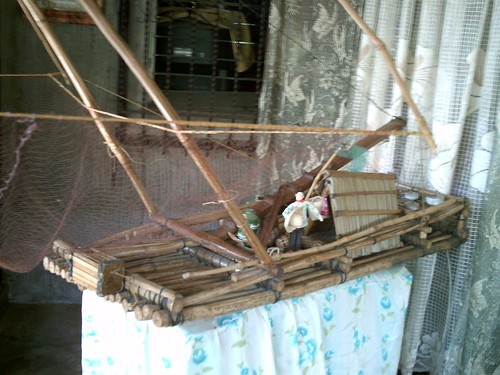Agriculture
The Banaue Rice Terraces
The Ifugaos of the mountainous region of the Cordilleras built irrigations, dams and hydraulic works and the famous Banaue Rice Terraces as a way for assisting in growing crops around 1000 BC.
They are part of the Rice Terraces of the Philippine Cordilleras, ancient sprawling man-made structures from 2,000 to 6,000 years old, which are a UNESCO World Heritage Site.

The Banaue Rice Terraces
Rice
Early Filipinos were good agriculturists. A report during the time of Miguel Lopez de Legazpi noted of the great abundance of rice, fowls, wine as well as great numbers of carabaos, deer, wild boar and goats in Luzon. In addition, there were also great quantities of cotton and colored clothes, wax, honey and date palms produced by the natives. In the Visayas, according to another early report, rice, cotton, swine, fowls, wax and honey abound. Leyte was said to produce two rice crops a year, and Pedro Chirino commented on the great rice and cotton harvests that were sufficient to feed and cloth the people.
Duck Culture
Duck culture was also practiced by the natives, particularly those around Pateros and Taguig. This resembled the Chinese methods of artificial incubation of eggs and the knowledge of every phase of a duck's life. This tradition is carried on until modern times.
Aquaculture
The natives were also involved in aquaculture and fishing. The natives make use of the salambao, which is a type of raft that utilizes a large fishing net which is lowered into the water via a type of lever made of two criss-crossed poles. Night fishing was accomplished with the help of candles made from a particular type of resin similar to the copal of Mexico. Use of safe pens for incubation and protection of the small fry from predators was also observed, and this method astonished the Spaniards at that time. During fishing, large mesh nets were also used by the natives to protect the young and ensure future good catches.

An artcraft portraying the Salambao way of fishing
Trade
Communities of ancient Philippines were active in international trade, and they used the ocean as natural highways. Early Filipinos were engaged in long-range trading with their Asian neighbors as far as west as Maldives and as far as north as Japan. Some historians even proposed that they also had regular contacts with the people of Western Micronesia because it was the only area in the Oceana that had rice crops, tuba (fermented coconut sap), and tradition of betel nut chewing when the first Europeans arrived there.
The uncanny resemblance of complex body tattoos among the Visayans and the Māori of Aotearoa also proved some interesting connection between Oceana and ancient Philippines. Magellan's chronicler, Antonio Pigafetta, mentioned that merchants and ambassadors from all surrounding areas cameto pay tribute to the king of Sugbu for the purpose of trade. While Magellan's crew were with the king, a representative from Siam was paying tribute to the king.
Miguel Lopez de Legazpi also wrote how merchants from Luzon and Mindoro had come to Cebu for trade, and he also mentioned how the Chinese merchants regularly came to Luzon for the same purpose. The Visayan Islands had earlier encounter with the Greek traders in 21 AD. Its people enjoyed extensive trade contacts with other cultures. Arabs, Indians, Vietnamese, Thais, Cambodians, Malays and Indonesians as trader or immigrants.
Mining
Mining in the Philippines began around 1000 BC. The early Filipinos worked various mines of gold, silver, copper and iron. Jewels, gold ingots, chains, calombigas and earrings were handed down from antiquity and inherited from their ancestors. Gold dagger handles, gold dishes, tooth plating, and huge gold ornamets were also used. In Laszlo Legeza's "Tantric elements in pre-Hispanic Philippines Gold Art", he mentioned that gold jewelry of Philippine origin was found in Ancient Egypt. According to Antonio Pigafetta, the people of Mindoro possessed great skill in mixing gold with other metals and gave it a natural and perfect appearance that could deceive even the best of silversmiths.The natives were also known for the jewelries made of other precious stones such as carnelian, agate and pearl. Some outstanding examples of Philippine jewelry included necklaces, belts, armlets and rings placed around the waist.
.jpg)
An example of a gold earrings

An example of a jewelry with precious stones


.jpg)
